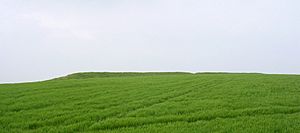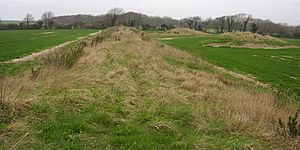Bank barrow facts for kids
A bank barrow is a very old type of tumulus, which is like a big mound of earth. People sometimes call them "barrow-banks" or "ridge mounds" too. A person named O.G.S. Crawford first officially named them in 1938.
In the United Kingdom, bank barrows look like long, winding mounds. They usually have ditches on both sides. They are about the same height and width all along their length. These amazing ancient monuments were built during the middle Neolithic period, which was a very long time ago! Sometimes, people have found burials inside them, but not in special burial rooms.
What are Bank Barrows?
Bank barrows are unique because of their shape. They are much longer than other types of ancient mounds. Imagine a very long, narrow hill that was built by people!
These mounds might have been built all at once. Or, they could have started as a smaller mound that people kept adding to over time. This made them grow into the long, ridge-like shapes we see today.
Historians and archaeologists believe these structures were important to the people who built them. They are from the middle Neolithic period. This means they are thousands of years old!

Where Can You Find Them?
Bank barrows are quite rare. There are fewer than 10 known bank barrows in the United Kingdom.
Some examples you can find are:
- At Maiden Castle, Broadmayne, and Martin's Down in Dorset.
- Long Low near Wetton in Staffordshire.
 In Spanish: Túmulo en loma para niños
In Spanish: Túmulo en loma para niños



